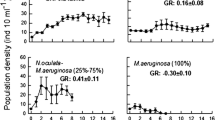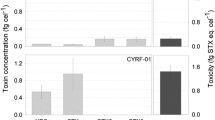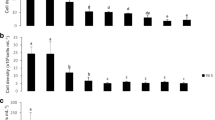Abstract
Cyanobacterial blooms are increasingly common in aquatic environments worldwide. These microorganisms cause concern due to their ability to produce cyanotoxins. Aquatic organisms, especially zooplankton, are exposed to cyanobacterial toxins by different routes, depending on the bloom phase. During cyanobacterial dominance, zooplankton is exposed to cyanotoxins through the ingestion of cyanobacterial cells, while at the bloom senescence, dissolved toxins are the most representative route. In this study, we assessed the effects of a microcystin-producing strain of Microcystis aeruginosa (NPLJ-4) on clones of the tropical small cladocerans Macrothrix spinosa (two clones) and Ceriodaphnia cornuta (one clone) exposed to intact cells and aqueous cell crude extracts. Short-term toxicity assays and life-table experiments were performed to assess the effects of the toxic M. aeruginosa on the survival and life history of the cladocerans. In the short-term toxicity assay, we found that cladocerans were more affected by intact cells. Both clones of M. spinosa were more affected when exposed to intact cells, while C. cornuta displayed about 5-fold more resistance. On the other hand, crude extracts had a low impact on cladocerans’ survival. Also, we observed a significant decrease in survival, fecundity, and growth of animals exposed to sublethal and environmentally relevant concentrations of M. aeruginosa cellular biomass. However, even at high concentrations of dissolved microcystins, the crude extract did not have significant effects on the life history parameters of the cladocerans. Although they can be found during cyanobacterial bloom events, small-bodied cladocerans are still affected by toxic Cyanobacteria depending on the exposure route.





Similar content being viewed by others
Availability of data and materials
The datasets used and/or analyzed during the current study are available from the corresponding author on reasonable request.
References
Abreu FQ, Ferrão-Filho AS (2013) Effects of an anatoxin-a (s)-producing strain of Anabaena spiroides (Cyanobacteria) on the survivorship and somatic growth of two Daphnia similis clones. J Environ Prot 4:12–18. https://doi.org/10.4236/jep.2013.46A002
Akbar S, Huang J, Zhou Q, Gu L, Sun Y, Zhang L, Lyu K, Yang Z (2021) Elevated temperature and toxic Microcystis reduce Daphnia fitness and modulate gut microbiota. Environ Pollut 271:1164092. https://doi.org/10.1016/j.envpol.2020.116409
Almeida VLS, Melão M da GG, Moura AN (2012) Plankton diversity and limnological characterization in two shallow tropical urban reservoirs of Pernambuco State. Brazil. An Acad Bras Cienc 84:537–550. https://doi.org/10.1590/S0001-37652012005000027
Amorim CA, Dantas ÊW, Moura AN (2020) Modeling cyanobacterial blooms in tropical reservoirs: the role of physicochemical variables and trophic interactions. Sci Total Environ 744:140659. https://doi.org/10.1016/j.scitotenv.2020.140659
Amorim CA, Moura AN (2021) Ecological impacts of freshwater algal blooms on water quality, plankton biodiversity, structure, and ecosystem functioning. Sci Total Environ 758:143605. https://doi.org/10.1016/j.scitotenv.2020.143605
Amorim CA, Ulisses C, Moura AN (2017) Biometric and physiological responses of Egeria densa Planch. cultivated with toxic and non-toxic strains of Microcystis. Aquat Toxicol 191:201–208. https://doi.org/10.1016/j.aquatox.2017.08.012
Bouaïcha N, Miles CO, Beach DG, Labidi Z, Djabri A, Benayache NY, Nguyen-Quang T (2019) Structural diversity, characterization and toxicology of microcystins. Toxins 11:714. https://doi.org/10.3390/toxins11120714
Buratti FM, Manganelli M, Vichi S, Stefanelli M, Scardala S, Testai E, Funari E (2017) Cyanotoxins: producing organisms, occurrence, toxicity, mechanism of action and human health toxicological risk evaluation. Arch Toxicol 91(3):1049–1130. https://doi.org/10.1007/s00204-016-1913-6
Calado SL de M, Vicentini M, Santos GS, Pelanda A, Santos H, Coral LA, … Silva de Assis HC (2019) Sublethal effects of microcystin-LR in the exposure and depuration time in a neotropical fish: multibiomarker approach. Ecotoxicol Environ Saf 183:109527https://doi.org/10.1016/j.ecoenv.2019.109527
Carmichael WW, Azevedo SMFO, An JS, Molica RJR, Jochimsen EM, Lau S, Rinehart KL, Shaw GR, Eaglesham GK (2001) Human fatalities from Cyanobacteria: chemical and biological evidence for cyanotoxins. Environ Health Perspect 109:663–668. https://doi.org/10.1289/ehp.01109663
Chen L et al (2021) Effects of acute exposure to microcystins on hypothalamic-pituitary-adrenal (HPA), -gonad (HPG) and -thyroid (HPT) axes of female rats. 2021. Sci Total Environ 778:145196. https://doi.org/10.1016/j.scitotenv.2021.145196
Chen L, Chen J, Zhang X, Xie P (2016) A review of reproductive toxicity of microcystins. J Hazard Mater 301:381–399. https://doi.org/10.1016/j.jhazmat.2015.08.041
Chorus I, Welker M (2021) Toxic cyanobacteria in water: a guide to their public health consequences, monitoring and management (p. 859). Second Edition. CRC Press, Boca Raton, World Health Organization, Geneva
Di Genaro AC, Sendacz S, de Almeida MBM, Mercante CTJ (2015) Dynamics of Cladocera community in a tropical hypereutrophic environment (Garças Reservoir, São Paulo, Brazil). J Water Resour Protect 7:379–388. https://doi.org/10.4236/jwarp.2015.75030
Fastner J, Flieger I, Neumann U (1998) Optimised extraction of microcystins from field samples—a comparison of different solvents and procedures. Water Res. 32:3177–3181. https://doi.org/10.1016/S0043-1354(98)00073-6
Ferrão-Filho AS, Azevedo SMFO, Demott WR (2000) Effects of toxic and non-toxic cyanobacteria on the life history of tropical and temperate cladocerans. Freshwat Biol 45:1–19. https://doi.org/10.1046/j.1365-2427.2000.00613.x
Ferrão-Filho AS, Azevedo SMFO (2003) Effects of unicellular and colonial forms of toxic Microcystis aeruginosa from laboratory cultures and natural populations on tropical cladocerans. Aquat Ecol 37:23–35. https://doi.org/10.1023/A:1022133329940
Ferrão-Filho ADS, Kozlowsky-Suzuki B (2011) Cyanotoxins: bioaccumulation and effects on aquatic animals. Mar Drugs 9:2729–2772. https://doi.org/10.3390/md9122729
Ferrão-Filho AS, Herrera NA, Echeverri LF (2014) Microcystin accumulation in cladocerans: first evidence of MC uptake from aqueous extracts of a natural bloom sample. Toxicon 87:26–31. https://doi.org/10.1016/j.toxicon.2014.05.015
Ferrão-Filho AS, Silva DAS, Oliveira TA, Magalhães VF, Pflugmacher S, Silva EM (2017) Single and combined effects of microcystin- and saxitoxin-producing cyanobacteria on the fitness and antioxidant defenses of cladocerans. Environ Toxicol Chem 36:2689–2697. https://doi.org/10.1002/etc.3819
Filatova D, Jones MR, Haley JA, Núñez O, Farré M, Janssen EML (2021) Cyanobacteria and their secondary metabolites in three freshwater reservoirs in the United Kingdom. Environ Sci Eur 33:29. https://doi.org/10.1186/s12302-021-00472-4
Ger KA, Panosso R (2014) The effects of a microcystin-producing and lacking strain of Microcystis on the survival of a widespread tropical copepod (Notodiaptomus iheringi). Hydrobiologia 738:61–73. https://doi.org/10.1007/s10750-014-1915-4
Ger KA, Urrutia-Cordero P, Frost PC, Hansson L-A, Sarnelle O, Wilson AE, Lürling M (2016) The interaction between cyanobacteria and zooplankton in a more eutrophic world. Harmful Algae 54:128–144. https://doi.org/10.1016/j.hal.2015.12.005
Gorham PR, Mclachlav JR, Hammer VT, Kim WK (1964) Isolation and culture of toxic strains of Anabaena flos-aquae (Lyngb.) de Bréd. Verh Int Verein Theor Angew Limnol 15:796–804. https://doi.org/10.1080/03680770.1962.11895606
Graham JL, Loftin KA, Meyer MT, Ziegler AC (2010) cyanotoxin mixtures and taste-and-odor compounds in cyanobacterial blooms from the Midwestern United States. Environ Sci Technol 44:7361–7368. https://doi.org/10.1021/es1008938
Guo N, Xie P (2006) Development of tolerance against toxic Microcystis aeruginosa in three cladocerans and the ecological implications. Environ Pollut 143:513–518. https://doi.org/10.1016/j.envpol.2005.11.044
Gu P, Li Q, Zhang W, Gao Y, Sun K, Zhou L, Zheng Z (2021) Biological toxicity of fresh and rotten algae on freshwater fish: LC50, organ damage and antioxidant response. J Hazard Mater 407:124620. https://doi.org/10.1016/j.jhazmat.2020.124620
Gustafsson S, Hansson L-A (2004) Development of tolerance against toxic cyanobacteria in Daphnia. Aquat Ecol 38:37–44. https://doi.org/10.1023/B:AECO.0000020985.47348.5e
Hamilton MA, Russo RC, Thurston RV (1977) Trimmed Spearman-Karber method for estimating median lethal concentrations in toxicity bioassays. Environ Sci Technol 11:714–719. https://doi.org/10.1021/es60130a004
Harke MJ, Steffen MM, Gobler CJ, Otten TG, Wilhelm SW, Wood SA, Paerl HW (2016) A review of the global ecology, genomics, and biogeography of the toxic cyanobacterium, Microcystis spp. Harmful Algae 54:4–20. https://doi.org/10.1016/j.hal.2015.12.007
Hillebrand H, Dürselen C-D, Kirschtel D, Pollingher U, Zohary T (1999) Biovolume calculation for pelagic and benthic microalgae. J Phycol 35:403–424. https://doi.org/10.1046/j.1529-8817.1999.3520403.x
Hairston NGJR, Holtmeier CL, Lampert W, Weider LJ, Post DM, Fischer JM, Cáceres CE, Fox JA, Gaedke U (2001) Natural selection for grazer resistance to toxic cyanobacteria: evolution of phenotypic plasticity? Evolution 55:2203–2214. https://doi.org/10.1111/j.0014-3820.2001.tb00736.x
Huisman J, Codd GA, Paerl HW, Ibelings BW, Verspagen JMH, Visser PM (2018) Cyanobacterial blooms. Nat Rev/Microbiol16https://doi.org/10.1038/s41579-018-0040-1
Jiang X, Li Q, Liang H, Zhao S, Zhang L, Zhao Y, Chen L, Yang W, Xiang X (2013) Clonal variation in growth plasticity within a Bosmina longirostris population: the potential for resistence to toxic Cyanobacteria. PloS One 8(9):e73540. https://doi.org/10.1371/journal.pone.0073540
Jiang X, Xie J, Xu Y, Zhong W, Zhu X, Zhu C (2016) Increasing dominance of small zooplankton with toxic cyanobacteria. Freshw Biol 62(2):429–443
Lawton LA, Edwards C, Codd GA (1994) Extraction and high-performance liquid chromatographic method for the determination of microcystins in raw and treated waters. Analyst 119:1525–1530. https://doi.org/10.1039/an9941901525
Li Y, Zhu Y, Ma L, Huang J, Sun Y, Zhang L, … Yang Z (2020) Toxic microcystis reduces tolerance of daphnia to increased chloride, and low chloride alleviates the harm of toxic Microcystis to Daphnia. Chemosphere 260:127594https://doi.org/10.1016/j.chemosphere.2020.127594
Lorenzi AS, Cordeiro-Araújo MK, Chia MA, Bittencourt-Oliveira MC (2018) Cyanotoxin contamination of semiarid drinking water supply reservoirs. Environ Earth Sci 77:595. https://doi.org/10.1007/s12665-018-7774-y
Lyu K, Gu L, Wang H, Zhu X, Zhang L, Sun Y, Huang Y, Yang Z (2018) Transcriptomic analysis dissects the mechanistic insight into the Daphnia clonal variation in tolerance to toxic Microcystis. Limnol Oceanogrhttps://doi.org/10.1002/lno.11038
Moura AN, Aragão-Tavares NKC, Amorim CA (2018) Cyanobacterial blooms in freshwater bodies from a semiarid region, Northeast Brazil: a review. J Limnol 77:179–188. https://doi.org/10.4081/jlimnol.2017.1646
Moustaka-Gouni M, Sommer U (2020) Effects of harmful blooms of large-sized and colonial Cyanobacteria on aquatic food webs. Water 12:1587. https://doi.org/10.3390/w12061587
Nandini S, Barrios CAZ, Sarma SSS (2020) A long-term study on the effect of cyanobacterial crude extracts from Lake Chapultepec (Mexico City) on selected zooplankton species. Environ Toxicol Chem https://doi.org/10.1002/etc.4875
Nandini S, Miracle MR, Vicente E, Sarma SSS, Gulati RD (2017) Microcystis extracts and single cells have differential impacts on the demography of cladocerans: a case study on Moina cf. micrura isolated from the Mediterranean coastal shallow lake (L’Albufera, Spain). Hydrobiologia 798:127–139. https://doi.org/10.1007/s10750-016-2665-2
Nandini S, Sánchez-Zamora C, Sarma SSS (2019) Toxicity of cyanobacterial blooms from the reservoir Valle de Bravo (Mexico): a case study on the rotifer Brachionus calyciflorus. Sci Total Environ 688:1348–1358. https://doi.org/10.1016/j.scitotenv.2019.06.297
Paerl HW, Otten TG (2013) Harmful cyanobacterial blooms: causes, consequences, and controls. Microb Ecol 65:995–1010. https://doi.org/10.1007/s00248-012-0159-y
R CORE TEAM (2020) R: a language and environment for statistical computing. Vienna: R Foundation for Statistical Computing 2020. https://www.R-project.org/. Accessed 20 July 2020
Rocha O, Duncan A (1985) The relationship between cell carbon and cell volume in freshwater algal species used in zooplanktonic studies. J Plankton Res 7:279–294. https://doi.org/10.1093/plankt/7.2.279
Rohrlack T, Christoffersen K, Dittmann E, Nogueira I, Vasconcelos V, Börner T (2005) Ingestion of microcystins by Daphnia: intestinal uptake and toxic effects. Limnol Oceanogr 50:440–448. https://doi.org/10.4319/lo.2005.50.2.0440
Santos GSD, Vilar MCP, Azevedo SMFO (2020) Acute toxicity of neurotoxin-producing Raphidiopsis (Cylindrospermopsis) raciborskii ITEP-A1 (Cyanobacteria) on the neotropical cladoceran Macrothrix spinosa. Ecotoxicol Environ Contam 15(1):1–8. https://doi.org/10.5132/eec.2020.01.01
Schwarzenberger A, Kurmayer R, Martin-Creuzburg D (2020) Toward disentangling the multiple nutritional constraints imposed by Planktothrix: the significance of harmful secondary metabolites and sterol limitation. Front Microbiol 11https://doi.org/10.3389/fmicb.2020.586120
Schwarzenberger A, Kurmayer R, Martin-Creuzburg D (2020) Toward disentangling the multiple nutritional constraints imposed by Planktothrix: the significance of harmful secondary metabolites and sterol limitation. Front Microbiol 11:586120. https://doi.org/10.3389/fmicb.2020.586120
Shahmohamadloo RS, Simmonsb DBD, Sibleya PK (2020) Shotgun proteomics analysis reveals sub-lethal effects in Daphnia magna exposed to cell-bound microcystins produced by Microcystis aeruginosa. Comp Biochem Physiol D 33:100656. https://doi.org/10.1016/j.cbd.2020.100656
Shishido TK, Kaasalainen U, Fewer DP, Rouhiainen L, Jokela J, Wahlsten M, Fiori MF, Yunes JS, Rikkinen J, Sivonen K (2013) Convergent evolution of [D-leucine1] microcystin-LR in taxonomically disparate cyanobacteria. BMC Evol Biol 13(1):1–16
Silva-Stenico ME, Silva CSP, Lorenzi AS, Shishido TK, Etchegaray A, Lira SP, Moraes LAB, Fiore MF (2011) Non-ribosomal peptides produced by Brazilian cyanobacterial isolates with antimicrobial activity. Microbiol Res 166:161–175. https://doi.org/10.1016/j.micres.2010.04.002
Sun X, Tao M, Qin B, Qi M, Niu Y, Zhang J, Ma Z, Xie P (2012) Large-scale field evidence on the enhancement of small-sized cladocerans by Microcystis blooms in Lake Taihu, China. J Plankton Res 34:853–863. https://doi.org/10.1093/plankt/fbs047
Svirčev Z, Drobac D, Tokodi N, Mijović B, Codd GA, Meriluoto J (2017) Toxicology of microcystins with reference to cases of human intoxications and epidemiological investigations of exposures to cyanobacteria and cyanotoxins. Arch Toxicol 91:621–650. https://doi.org/10.1007/s00204-016-1921-6
Svirčev Z, Lalić D, Bojadžija Savić G, Tokodi N, Backović DD, Chen L, Meriluoto J, Codd GA (2019) Global geographical and historical overview of cyanotoxin distribution and cyanobacterial poisonings. Arch Toxicol 93:2429–2481. https://doi.org/10.1007/s00204-019-02524-4
Taberner A, Castaera P, Silvestre E, Dopazo J (1993) Estimation of the intrinsic rate of natural increase and its error by both algebraic and resampling approaches. Bioinformatics 9:535–540. https://doi.org/10.1093/bioinformatics/9.5.535
Vesterkvist PSM, Misiorek JO, Spoof LEM, Toivola DM, Meriluoto JAO (2012) Comparative cellular toxicity of hydrophilic and hydrophobic microcystins on Caco-2 cells. Toxins 4:1008–1023. https://doi.org/10.3390/toxins4111008
Acknowledgements
This work was supported by the Brazilian National Council of Technological and Scientific Development - CNPq, Brazil (grant number 305829/2019-0) and Coordination for the Improvement of Higher Education Personnel - CAPES (Finance Code 001).
Author information
Authors and Affiliations
Contributions
ASAS, MCPV, and ANM participated in the conceptualization and methodology development; ASAS, MCPV, RJRM, and ANM participated in the validation and data curation; ASAS and CAA analyzed the data and performed the statistical analyses; ANM, MCPV, and RJRM participated in the supervision and funding acquisition; ASAS wrote the original draft; all authors wrote, reviewed, edited, read, and approved the final version of the manuscript.
Corresponding author
Ethics declarations
Ethics approval and consent to participate
Not applicable.
Consent for publication
Not applicable.
Competing interests
The authors declare no competing interests.
Additional information
Responsible Editor: Vitor Vasconcelos
Publisher's note
Springer Nature remains neutral with regard to jurisdictional claims in published maps and institutional affiliations.
Supplementary Information
Below is the link to the electronic supplementary material.
Rights and permissions
About this article
Cite this article
de Aquino Santos, A.S., Vilar, M.C.P., Amorim, C.A. et al. Exposure to toxic Microcystis via intact cell ingestion and cell crude extract differently affects small-bodied cladocerans. Environ Sci Pollut Res 29, 23194–23205 (2022). https://doi.org/10.1007/s11356-021-17402-9
Received:
Accepted:
Published:
Issue Date:
DOI: https://doi.org/10.1007/s11356-021-17402-9




